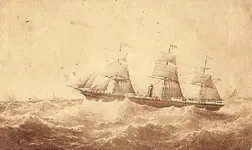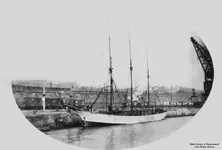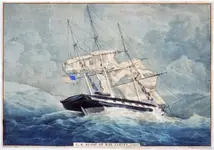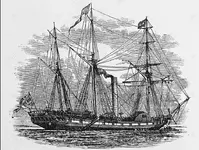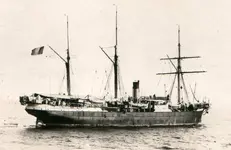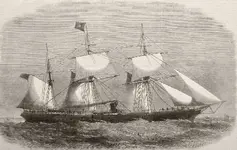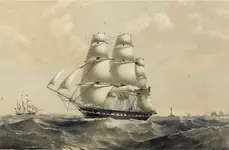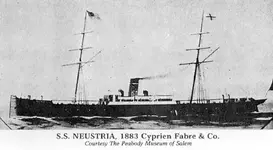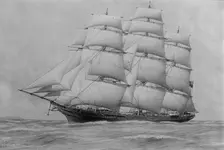Crow
Silver Member
- Joined
- Jan 28, 2005
- Messages
- 4,034
- Reaction score
- 11,236
- Golden Thread
- 0
- Location
- In a tax haven some where
- Detector(s) used
- ONES THAT GO BEEP! :-)
- Primary Interest:
- Other
Gidday Amigos
Here is few more missing vessels.
F/V Andrea Gail below was a commercial fishing vessel that was lost at sea with all hands during the Perfect Storm of 1991. The vessel and her six-man crew had been fishing the North Atlantic Ocean out of Gloucester, Massachusetts. Her last reported position was 180 mi (290 km) northeast of Sable Island on October 28, 1991. The story of Andrea Gail and her crew was the basis of the 1997 book The Perfect Storm by Sebastian Junger, and a 2000 film adaptation of the same name.

Lake Huron keep its secrets well also? The SS James Carruthers below was a Canadian Great Lakes freighter built in 1913. The ship was owned by the St. Lawrence & Chicago Steam and Navigation Company of Toronto, Ontario, with the official registry number 131090. The Carruthers was lost 9 November 1913 on Lake Huron during the Great Lakes Storm of 1913. The crew of 22 perished with the vessel. Although looking at the picture the vessel seems frightfully fragile in breaking in two?

Lake Superior has a bite too? The SS Leafield below was hauling steel rails, bound for Midland, when she sank in deep water in Lake Superior, probably off the Angus Rocks in the Angus Islands, about 14 miles (23 km) southeast of Port Arthur, Ontario, on 9 November 1913 during the Great Lakes storm of 1913. Her entire crew of 18 perished. A search found no trace of the ship or crew.

SS Chicora below was a passenger-and-freight steamer built in 1892 for service on the Great Lakes. Considered to be one of Lake Michigan's finest steamers, she was lost with all hands in January 1895. She is now remembered chiefly for being mentioned by Chicago writer Nelson Algren, in Algren’s prose-poem, Chicago: City on the Make: “Who now knows the sorrowful long-ago name of the proud steamer Chicora, down with all hands in the ice off South Haven?” as well as “Sunk under the ice in the waves off South Haven, sunk with all hands for good and forever, for keeps and a single day.”

HMS Atalanta below was a 26-gun Spartan-class sixth-rate frigate of the Royal Navy launched in 1844 at Pembroke. Built as HMS Juno, she carried out the historic role in 1857 of annexing the Cocos (Keeling) Islands to the British Empire. She was renamed HMS Mariner in January 1878 and then HMS Atalanta two weeks later. Atalanta was serving as a training ship when in 1880 she disappeared with her entire crew after setting sail from the Royal Naval Dockyard in Bermuda for Falmouth, England on 31 January 1880. It was presumed that she sank in a powerful storm which crossed her route a couple of weeks after she sailed.

Crow
Here is few more missing vessels.
F/V Andrea Gail below was a commercial fishing vessel that was lost at sea with all hands during the Perfect Storm of 1991. The vessel and her six-man crew had been fishing the North Atlantic Ocean out of Gloucester, Massachusetts. Her last reported position was 180 mi (290 km) northeast of Sable Island on October 28, 1991. The story of Andrea Gail and her crew was the basis of the 1997 book The Perfect Storm by Sebastian Junger, and a 2000 film adaptation of the same name.
Lake Huron keep its secrets well also? The SS James Carruthers below was a Canadian Great Lakes freighter built in 1913. The ship was owned by the St. Lawrence & Chicago Steam and Navigation Company of Toronto, Ontario, with the official registry number 131090. The Carruthers was lost 9 November 1913 on Lake Huron during the Great Lakes Storm of 1913. The crew of 22 perished with the vessel. Although looking at the picture the vessel seems frightfully fragile in breaking in two?
Lake Superior has a bite too? The SS Leafield below was hauling steel rails, bound for Midland, when she sank in deep water in Lake Superior, probably off the Angus Rocks in the Angus Islands, about 14 miles (23 km) southeast of Port Arthur, Ontario, on 9 November 1913 during the Great Lakes storm of 1913. Her entire crew of 18 perished. A search found no trace of the ship or crew.
SS Chicora below was a passenger-and-freight steamer built in 1892 for service on the Great Lakes. Considered to be one of Lake Michigan's finest steamers, she was lost with all hands in January 1895. She is now remembered chiefly for being mentioned by Chicago writer Nelson Algren, in Algren’s prose-poem, Chicago: City on the Make: “Who now knows the sorrowful long-ago name of the proud steamer Chicora, down with all hands in the ice off South Haven?” as well as “Sunk under the ice in the waves off South Haven, sunk with all hands for good and forever, for keeps and a single day.”
HMS Atalanta below was a 26-gun Spartan-class sixth-rate frigate of the Royal Navy launched in 1844 at Pembroke. Built as HMS Juno, she carried out the historic role in 1857 of annexing the Cocos (Keeling) Islands to the British Empire. She was renamed HMS Mariner in January 1878 and then HMS Atalanta two weeks later. Atalanta was serving as a training ship when in 1880 she disappeared with her entire crew after setting sail from the Royal Naval Dockyard in Bermuda for Falmouth, England on 31 January 1880. It was presumed that she sank in a powerful storm which crossed her route a couple of weeks after she sailed.
Crow








